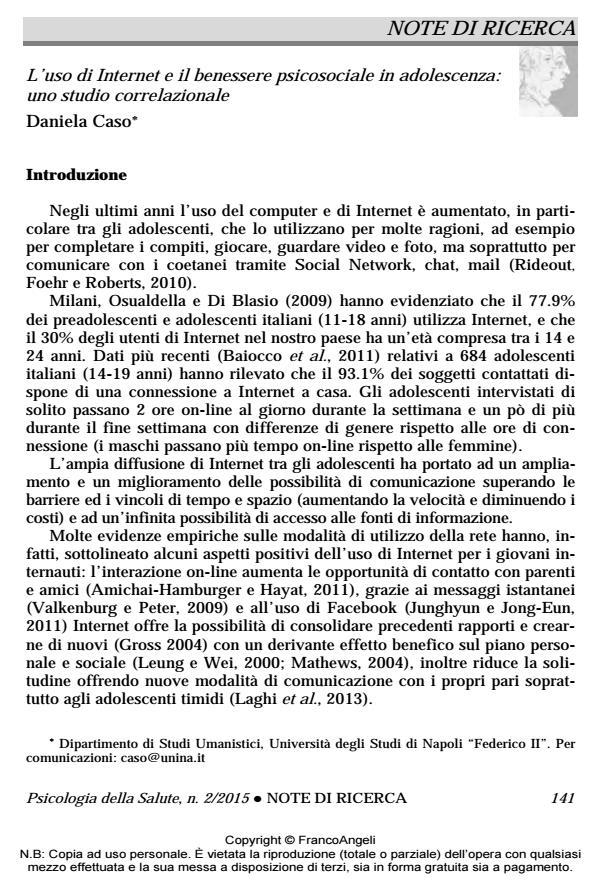L’uso di Internet e il benessere psicosociale in adolescenza: uno studio correlazionale
Journal title PSICOLOGIA DELLA SALUTE
Author/s Daniela Caso
Publishing Year 2015 Issue 2015/2
Language Italian Pages 15 P. 141-155 File size 123 KB
DOI 10.3280/PDS2015-002008
DOI is like a bar code for intellectual property: to have more infomation
click here
Below, you can see the article first page
If you want to buy this article in PDF format, you can do it, following the instructions to buy download credits

FrancoAngeli is member of Publishers International Linking Association, Inc (PILA), a not-for-profit association which run the CrossRef service enabling links to and from online scholarly content.
Recent studies have shown several positive/beneficial aspects of young user’s usage of the Internet, including: increased opportunities for connection with relatives and friends, the decrease of loneliness through new ways of communication with their peers. Excessive use or even abuse of the Internet can, on the contrary, have negative effects on the psychosocial well-being and could result in addiction. This explorative study aims to detect the levels of use and/or abuse of the Internet, and the psychosocial functioning of individuals in terms of mental health and mental illness of teenagers from Campania. Differences by gender, age and duration of web surfing were also investigated. They (the teenagers) were given a self-report questionnaire with the aim of detecting the levels of psychological, emotional and social wellness; mental illness and Internet addiction due to its use and/or abuse. Four hundred fifty-four students have taken part to the research, with an average age of 15.83 years and an on-line time of about 5.30 hours per day. The results reveal that girls have higher levels of unease and addiction, as well as the younger ones who surf the Internet for several hours a day. Even though with the limitations of a correlational research, the results of this explorative study can provide useful starting points for the starting of interventions aimed to the prevention of Internet addiction and the promotion of psychosocial well-being during the adolescence.
Keywords: Adolescents, use and/or abuse of the Internet, psychosocial well-being, mental illness.
- Randomised controlled trial of a text messaging intervention for reducing processed meat consumption: The mediating roles of anticipated regret and intention V. Carfora, D. Caso, M. Conner, in Appetite /2017 pp.152
DOI: 10.1016/j.appet.2017.06.025 - The dark side of #bodypositivity: The relationships between sexualized body-positive selfies on Instagram and acceptance of cosmetic surgery among women Giovanni Schettino, Miriam Capasso, Daniela Caso, in Computers in Human Behavior 107586/2023 pp.107586
DOI: 10.1016/j.chb.2022.107586 - Families and Social Media Use: The Role of Parents’ Perceptions about Social Media Impact on Family Systems in the Relationship between Family Collective Efficacy and Open Communication Fortuna Procentese, Flora Gatti, Immacolata Di Napoli, in International Journal of Environmental Research and Public Health /2019 pp.5006
DOI: 10.3390/ijerph16245006 - Correlational study and randomised controlled trial for understanding and changing red meat consumption: The role of eating identities V. Carfora, D. Caso, M. Conner, in Social Science & Medicine /2017 pp.244
DOI: 10.1016/j.socscimed.2017.01.005 - “Change my selfie”: Relationships between self‐objectification and selfie‐behavior in young Italian women Daniela Caso, Giovanni Schettino, Rosa Fabbricatore, Mark Conner, in Journal of Applied Social Psychology /2020 pp.538
DOI: 10.1111/jasp.12693 - Social Media Literacy to Support a Conscious Use of Social Media in Adolescents and Improve Their Psychological Well-Being: A Pilot Study Davide Taibi, Lidia Scifo, Nicola Bruno, Giovanni Fulantelli, in Sustainability /2023 pp.12726
DOI: 10.3390/su151712726 - The Mediating Roles of Attitude Toward COVID-19 Vaccination, Trust in Science and Trust in Government in the Relationship Between Anti-vaccine Conspiracy Beliefs and Vaccination Intention Miriam Capasso, Daniela Caso, Gregory D. Zimet, in Frontiers in Psychology 936917/2022
DOI: 10.3389/fpsyg.2022.936917
Daniela Caso, L’uso di Internet e il benessere psicosociale in adolescenza: uno studio correlazionale in "PSICOLOGIA DELLA SALUTE" 2/2015, pp 141-155, DOI: 10.3280/PDS2015-002008